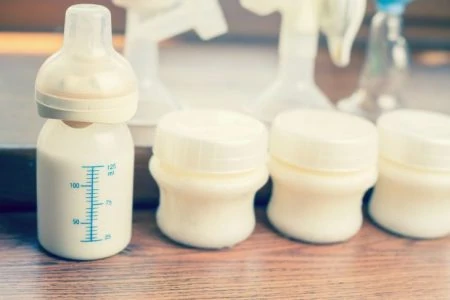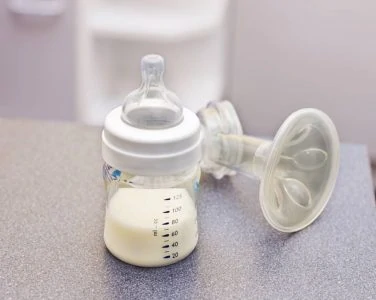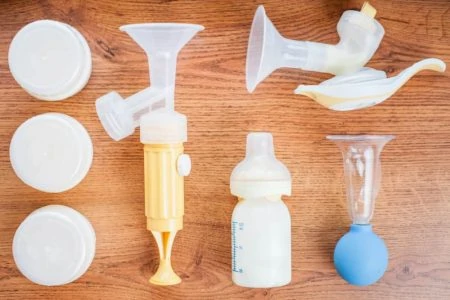Throughout history, babies have been fed by people other than those who gave birth to them. In some cases, a wet nurse was used. But in others, induced lactation was used so that a baby and caregiver could enjoy the benefits of breastfeeding.
Here we have compiled all you need to know about induced lactation: who can do it, how it’s done, and what your chances of success are.
Key Takeaways
- Induced lactation is when a caregiver who has not been pregnant breastfeeds their baby.
- Anyone with a healthy pituitary gland can potentially lactate by following the right process.
- To induce lactation, the essential step is to stimulate the breasts using a breast pump regularly.
- Hormone therapy and lactation supplements, like galactagogues, can help but are not essential for successful induced lactation.
What Is Induced Lactation/Adoptive Breastfeeding?
Induced lactation/adoptive breastfeeding is where a caregiver who has not physically been pregnant and carried the baby themselves breastfeeds their baby.
This can happen when someone adopts a baby, has a baby with a surrogate, is the partner of someone who has been pregnant, or becomes a parent in any other way.
Can You Induce Lactation Without Being Pregnant?
Yes, it is possible to induce lactation without being pregnant.
The hormone responsible for ongoing milk production is prolactin. This is produced by the pituitary gland, which is located at the base of the brain. So, in theory, anyone with a healthy pituitary gland can lactate.
In practice, some people will be able to produce all the milk their baby needs, while others will be able to breastfeed but may need supplemental feeds. A small number of people will not be able to induce lactation.
How Lactation Works
During pregnancy, the placenta produces progesterone and estrogen, increasing levels in the body. At the same time, the pituitary gland at the base of the brain produces prolactin. After delivery, progesterone and estrogen levels plummet, but prolactin levels remain high.
In tandem with the higher prolactin levels in the body, this drop in progesterone and estrogen induces lactation.
When a baby suckles at the breast, or when the breast is stimulated by a pump, the breast sends a signal to the brain. The brain responds by releasing oxytocin which triggers the “let-down reflex” and causes milk to flow.
Once the physical process of breastfeeding, or pumping, begins, milk is produced on a supply and demand basis. The more the breasts are stimulated and drained, and the more prolactin and oxytocin is released, the more milk is produced.
How to Induce Lactation
To induce lactation, you have to recreate the physical processes that occur in the body during pregnancy, childbirth, and the postpartum period.
There are three arms of the process, not all of which are essential.
- Mimic the physical changes that take place during pregnancy. It usually happens hormonally, so it requires artificial hormones. Thankfully, this step is not essential.
- Stimulate the breasts. This happens slowly with induced lactation rather than in the sudden rush that happens when you give birth. This is the only step you positively have to take if you want to induce lactation.
- Boost levels of milk production. Certain foods or substances are thought to boost the level of milk production. These may be helpful for some people, but are not guaranteed to work. Again, this step is not essential to successful induced lactation.
1. Hormone Therapy
If you have at least 3 to four months in which to prepare, a doctor can prescribe hormone therapy to mimic the hormone levels of pregnancy. You will take a combination of estrogen and progesterone until roughly six weeks before you plan to begin breastfeeding (1).
This step is helpful but not critical to success.
2. Breast Stimulation
Recreating the physical process of breastfeeding by using a breast pump causes the body to produce prolactin and oxytocin. The release of these hormones results in lactation.
The best results come from using a hospital-grade breast pump that you can use on both breasts at once. The standard regime is to pump for:
- Five minutes three times a day for five days.
- Ten minutes every four hours with no more than six hours between sessions in the night. Continue this process for five days.
- Finally, pump for 15 to 20 minutes every two to three hours until your supply is established.
Any milk you produce during this process can be stored and given to your baby at a later date.
3. Galactagogues
A galactagogue is a substance that stimulates or increases lactation. They can be prescription medications, herbal supplements, homeopathic compounds, or other substances.
Galactagogues are not necessary to induce lactation, may not work for everyone, and are only useful when taken in conjunction with an appropriate pumping routine.
How Much Fenugreek Do I Take to Induce Lactation?
Fenugreek is a herb, similar to clover, which some people believe increases lactation. A recent review of scientific studies decided the evidence for the efficacy of Fenugreek was inconclusive (2).
The standard dose is to take 3 x 500mg capsule three times a day — nine pills a day in total.
However, Fenugreek lowers blood sugar, so it is not suitable for people with diabetes. It can also cause nausea and vomiting in the adult and diarrhea in the baby.
Do Lactation Supplements Work?
The jury is out on most lactation supplements with some studies showing they work and others concluding they do not (3).
The only galactagogue that appears to demonstrate an increase in the reproduction of breastmilk is domperidone. However, it is unclear whether, in these cases, it was the domperidone or other interventions that were responsible.
Will Domperidone Make Me Lactate?
Domperidone is a prescription-only medication that is not licensed for use in the promotion of lactation. It should only be tried after all other interventions have been unsuccessful. The standard dose is one or two 10mgs capsules 3 times a day.
What Herbs Induce Lactation?
- Fennel has estrogen-like properties that some people believe can boost lactation. It is also good for digestion and is thought to pass through the breastmilk and help alleviate colic (4).
- Alfalfa is full of nutrients and is fed to dairy cows to increase their milk supply. There are no known disadvantages to consuming alfalfa in moderation, so it’s worth a try.
- Blessed Thistle may help increase lactation but should not be taken during pregnancy as it can stimulate uterine contractions.
- Goats Rue is a member of the same plant family as fenugreek and could have similar properties.
If you consider herbal supplements, make sure you only do so after consultation with your medical professional.
FAQs About Induced Lactation
These are the most common induced lactation questions.
Breastfeeding in Progress
Breastfeeding promotes the close physical and emotional bond between a baby and the person feeding them. Induced lactation can make this a viable reality for parents who have not gone through the physical process of pregnancy and giving birth.
Hormone therapy and lactation stimulants can help, but the important step is to adopt a regime of pumping and stimulation that will simulate breastfeeding and trick your body into believing it is feeding a baby.










